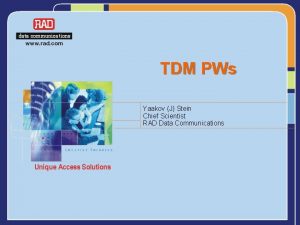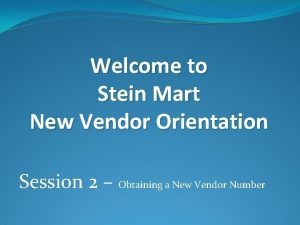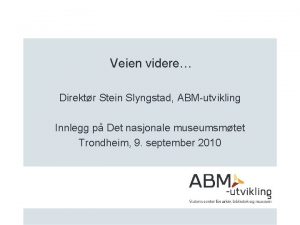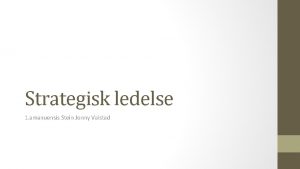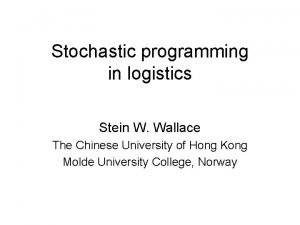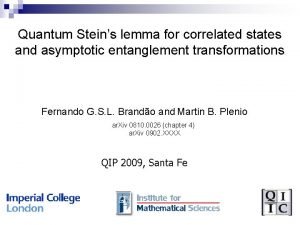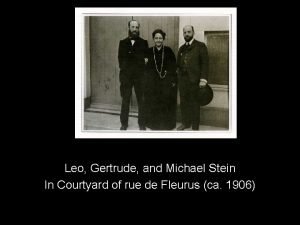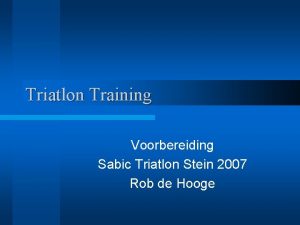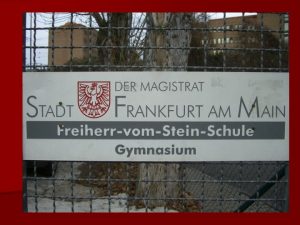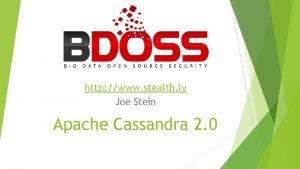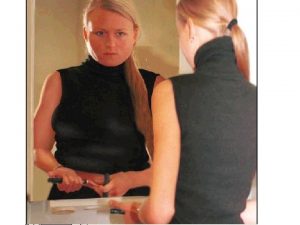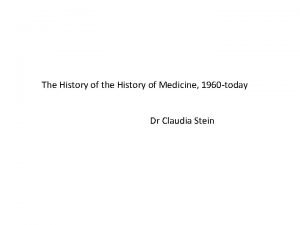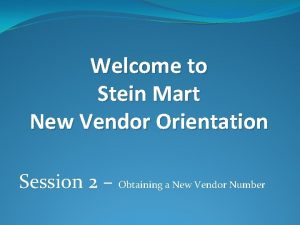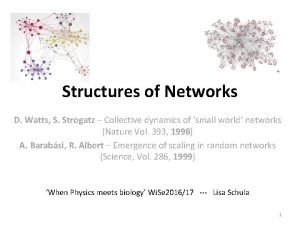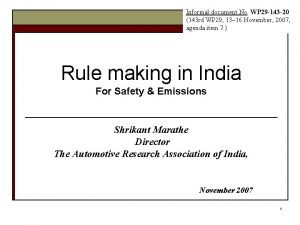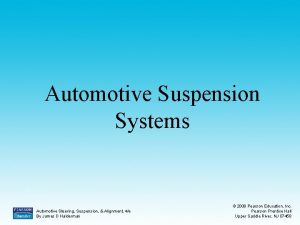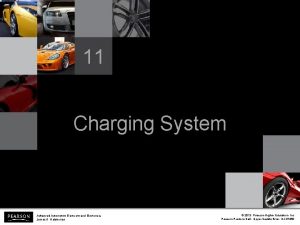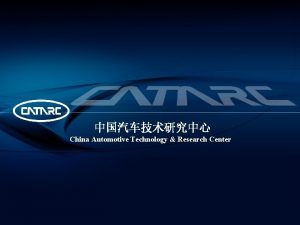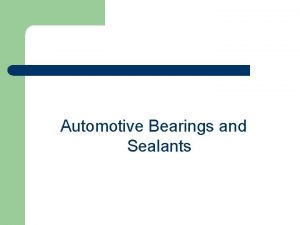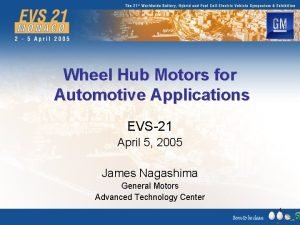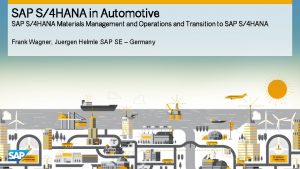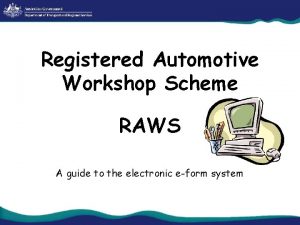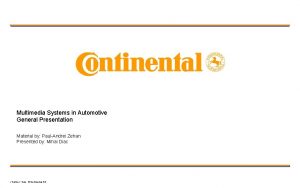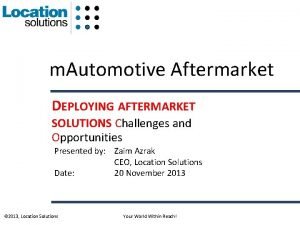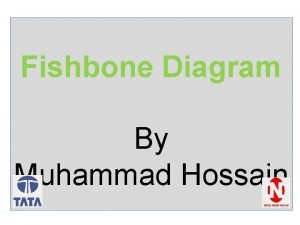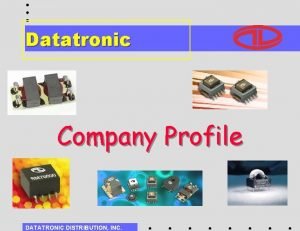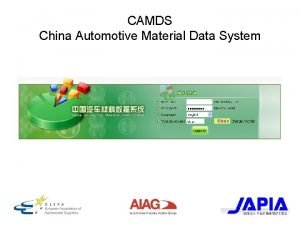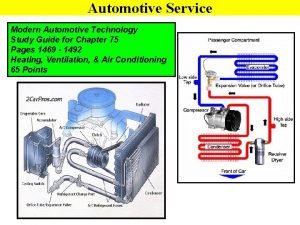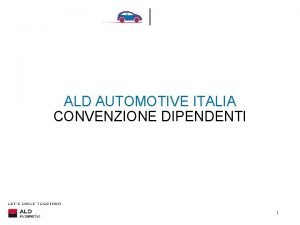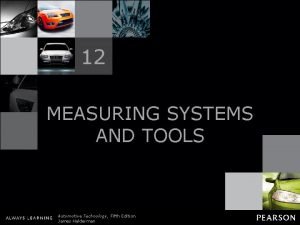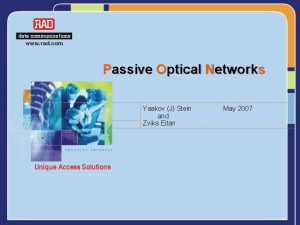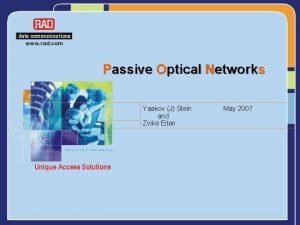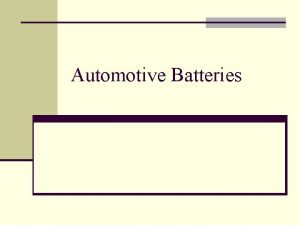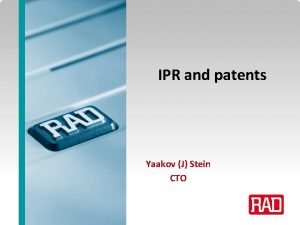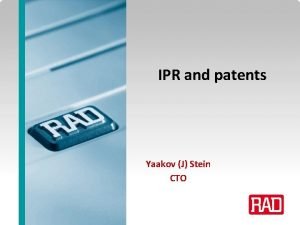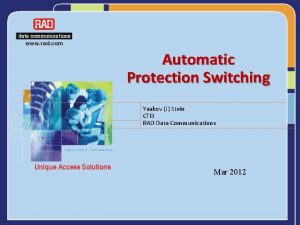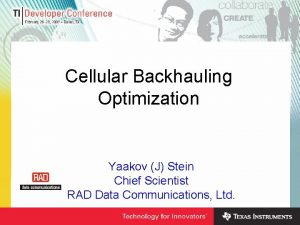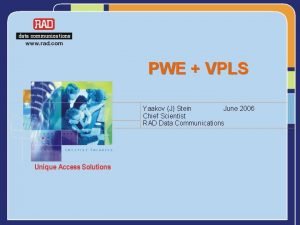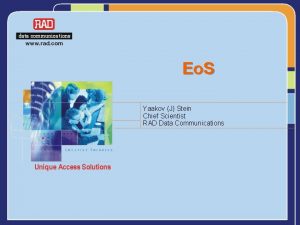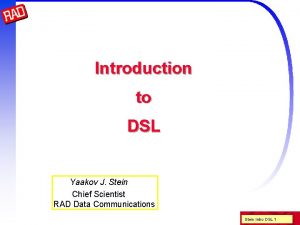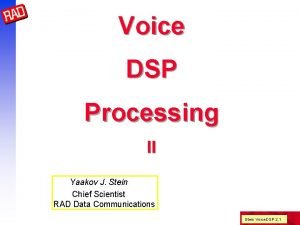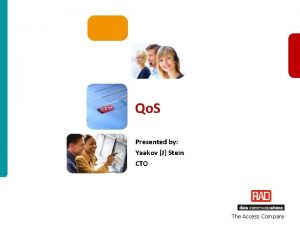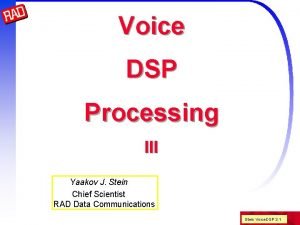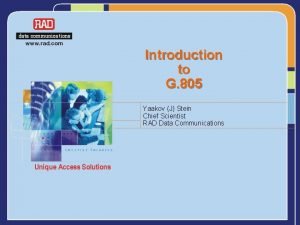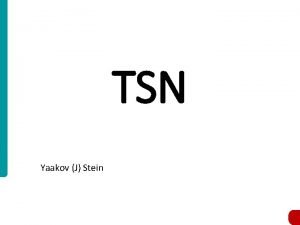Yaakov J Stein Automotive networks and the world





































































































- Slides: 101

Yaakov (J) Stein Automotive networks and the world of SOME/IP

ECUs An Electronic Control Unit (ECU) is exactly what you would imagine an electronic unit for controlling a (mechanical/electrical) system The term is mostly used in automotive systems where it can be confused with a specific ECU - the Engine Control Unit What exactly does an ECU do? • input one or more (sensor) indications from the controlled system ECU • perform some calculation (all modern ECUs contain a CPU!) • output one or more signals (actuations) sensor actuator to alter the operation of the controlled system Y(J)S SOME/IP 2

What’s an ECU made of? Modern ECUs are So. Cs (Systems on Chip) usually containing: • CPU (8/16/32 -bit, 10 -100 MHz) • flash memory for the software (≤ 1 MB) • RAM for data (not always) • signal conditioners, A/Ds, D/As, relays, etc. • I/O ports (e. g. , for diagnostics) • communications interfaces (most of this talk!) Most ECUs today are specific to the car manufacturer and even to a model Y(J)S SOME/IP 3

For example? Modern cars can have between 10 and 100 ECUs, for example: • • • • Engine Control Unit (ECU) (fuel injection, air/fuel ratio, ignition timing, temp. correction, …) Transmission Control Unit* (automatic gear) Power Steering Controller Battery Management System Windshield Wiper Controller Speed Control Unit (cruise control) Brake Control Unit (ABS, anti-skidding) Turn Signal Control Module (blinkers) Air bags Tire pressure Light Control Module (headlights, rear lights, cabin lights) Body Control Unit(s) (A/C, immobilizer, door/window/mirror control/…) Advanced Driver Assistance System Multimedia system Parking video camera * WARNING: TCU also used for Telematics Control Unit Y(J)S SOME/IP … 4

Newer ECUs As cars become more sophisticated there are more ECUs • keyless entry • remote start • all-passenger personal infotainment • Automatic Vehicle Location (telelocation) • radar/lidar distance measurement • lane assist • 360 degree parking assist • traffic sign recognition • pedestrian detection • V 2 X (V 2 V, V 2 I, V 2 P, …) including over 5 G Y(J)S SOME/IP 5

And more futuristic! • Augmented Reality dashboards / steering wheels • distance and identification overlaid over objects on the road • dangers highlighted • platooning V 2 V • fully self-driving (autonomous) delivery vehicles • photoelectric recharging of electric vehicles Y(J)S SOME/IP 6

Why not a single CPU? Why are there so many ECUs instead of a single Central Processing Unit? History • automotive technology has developed over time so it was natural to add an independent local ECU for each new feature Real time • there may be tight delay constraints between sensing and actuation • using separate ECUs eliminates most process queuing delays Reliability • When there are critical reliability requirements, modularization • avoids single point of system-wide failure • makes it simpler to develop bug-free code and prove correctness Y(J)S SOME/IP 7

Communications Because it is composed of many ECUs the automobile itself is essentially a distributed multiprocessor (parallel) computation system Some of these ECUs are, and should remain, completely independent For example, it’s a really bad idea to allow the multimedia controller to access the steering or braking systems! ( see https: //www. youtube. com/watch? v=MK 0 Srx. BC 1 xs ) But many ECU do need to exchange information, for example: • • Engine Control Unit and Transmission Control Unit (many interactions!) reverse/parking controller needs TCU trigger Body Control Unit needs to lock doors upon attaining some speed diagnostics and dashboard instrumentation need data from almost all systems Y(J)S SOME/IP 8

The original solution With the proliferation of ECUs and their communications requirements automotive manufacturers started connecting them up using dedicated point-to-point links (some analog some digital) each with its own proprietary protocol This solution does have several advantages • only ECUs truly requiring communications are interconnected (compartmentalization is good for security!) • single purpose protocols may be simpler to design (at least the 1 st time!) but resulted in numerous problems • tremendous number of cables ( O(N 2) ) • difficult to aggregate information for instrumentation and diagnosis • R&D and maintenance complexity Y(J)S SOME/IP 9

The cost of networking ECUs Over time the complexity, cost, and weight of wiring harnesses has significantly increased to the point where they are non-negligible Old cars have under 100 wires, reaching about 50 meters in length while modern cars can have over 1000 wires exceeding 1 km in length In fact • wiring up can comprise 50% of the manufacturing labor cost • copper wiring can add 25 kg to car’s weight There is thus a strong drive for upgrading conventional communications with modern more efficient networking solutions It has been estimated that cost reduction may be up to 75% Y(J)S SOME/IP 10

Automotive network standards Vendors, automotive industry groups, and standards organizations have come up with networking standards for ECU interconnection • Controller Area Network bus (CAN bus) [ISO 11898 -1 … 11898 -6] • Local Interconnect Network (LIN bus) • Flex. Ray [ISO 17458 -1 … 17458 -5] • Media Oriented Systems Transport (MOST bus) • Time-Triggered Ethernet (TTTech) [SAE AS 6802] • Scalable service-Oriented Middleware over IP (SOME/IP) • application specific e. g. , K-line diagnostics, OBD-II diagnostics and emissions monitoring We’ll discuss some of the most important of these Y(J)S SOME/IP 11

CAN bus Right now CAN bus is the dominant automotive ECU networking protocol nearly every automobile sold today has a CAN bus! Like many current ECU networking protocols the physical layer of CAN bus is a multi-master serial bus • all ECUs are connected in parallel and all messages are broadcast • the physical bus is balanced 2 -wire (with termination resistors at bus ends) with differential voltage across these wires and NRZ encoding • any ECU can transmit at any time • all ECUs receive all messages, but only act on particular message IDs • CAN nodes don’t have L 2 addresses (since topology is considered unimportant) but higher layers over CAN may support addressing Y(J)S SOME/IP 12

CAN bus history 1983 Bosch (German manufacturer) started development of CAN bus 1987 Intel produced the first CAN controller chips 1991 Mercedes Benz produced the first vehicle with CAN bus 1993 ISO released ISO 11898 for CAN bus, later divided into • 11898 -1 for layer 2 • 11898 -2 for layer 1 at 1 Mbps • 11898 -3 for layer 1 at speeds up to 125 kbps • 15765 -2 for layers 3 and 4 1994 CAN bus became the de-facto L 1/L 2 standard in all US cars 2001 CAN bus became the de-facto L 1/L 2 standard for European cars Y(J)S SOME/IP 13

CAN speeds CAN buses are typically rated based on their speed • Class A rating carries less than 10 Kbps for power windows, mirrors, seats, door locks, trunk releases, lights • Class B rating from 10 Kbps up to 125 Kbps (SAE J 1850 or ISO 9141 -2) for instrumentation, transmission, security systems, climate control • Class C speeds up to 1 megabits per second (many at 500 Kbps) for powertrain, ABS, stability control • Class D is a proposal for speeds over 1 Mbps for onboard entertainment systems, video streaming • Some vendors define proprietary classes based on 2 buses – low and high speed • GMLAN: low speed 33. 33 Kbps and high speed 500 Kbps • Mercedes: low speed 83 kbps and high speed 500 Kbps Y(J)S SOME/IP 14

CAN Multiple access method ECUs on a CAN bus may want to transmit at any time and so some Multiple Access mechanism must be provided CAN bus uses bit-wise deterministic collision avoidance the message with highest priority (lowest message ID) gains access and all other transmitters must stop and wait Note that the message ID is the first field in the message minimizing the arbitration time Strict priority based arbitration results in • highest priority messages always transmitted with no delay • lower priority messages preempted but transmitted afterwards • straightforward analysis of latency for all messages Y(J)S SOME/IP 15

How are messages transmitted in CAN bus ? All CAN messages are broadcast to every ECU on the bus Every message starts with a single Start of Frame bit (0) and ends with End of Frame field (seven 1 bits) between messages there is a frame gap (at least three 1 bits) Bit stuffing is used if 7 consecutive 1 s happened to appear in a message Messages contain: • message type identifier (also used as priority indicator) • all receivers observe and consume relevant messages • message ID meanings are proprietary to manufacturers • control bits and up to eight data bytes • 15 -bit CRC field for error detection (all single bit errors detected) Y(J)S SOME/IP 16

CAN frame types There are 4 kinds of CAN bus messages (frames) • Data – ECU broadcasts message to all other ECUs • Remote – sent to request data from a specific node • Error – transmitted by node detecting a bus error • Overload – (OBSOLETE) request more delay between data/remote frames Examples • blinker ECU sends data frame with data indicating its state in order to • turn on blinker lights • turn on clicker sound and indicator on dashboard • suppress lane departure warning • central locking controller needs to know if the car is in park • it sends a remote frame to TCU requesting park status • TCU responds with data frame containing park status Y(J)S SOME/IP 17

Data frames (CAN 2. 0 format) Just for concreteness, let’s describe a CAN data frame (classic format) • Start of Frame (1 bit) equals 0 • Message ID (11 bits in base CAN, 29 bits in extended CAN) standard and extended frames may coexist, standard having higher priority • Remote Transmission Request (1 bit) 0 in data frames, 1 in remote frames • Reserved (2 bits) set to 0 • Data Length Code (4 bits) number of data bytes 0… 8) • Data (0… 8 bytes) serialized information, MSB sent first • Cyclic Redundancy Check (15 bits) • ACK (2 bits including Ack delimiter) indicates previous message passed CRC • End of Frame (7 bits) all 1 s Y(J)S SOME/IP 18

CAN serialization In serial protocols • serialization is the process of formatting data into a sequence of bits • deserialization is the recovery of data structures from the bit stream The CAN specification details its serialization functions, such as • MSB is always transmitted first • big-endian / little-endian for multibyte data is manufacturer dependent • fields need not start on byte boundaries • bit stuffing • a maximum of 5 consecutive 0 or 1 bits is allowed • if the data has >5 identical bits an additional opposite bit is inserted Y(J)S SOME/IP 19

CAN diagnostics CAN bus scanners are used by technicians to diagnose problems A CAN connector is located under the hood and/or under the dashboard The scanner receives and logs all CAN messages Another use is emissions conformance testing during annual test or when requested by authorities All modern cars have On. Board Diagnosis II usually based on CAN Y(J)S SOME/IP 20

Higher layers CAN defines L 1 and L 2, but leaves higher layers to other protocols, e. g. : • • • ARINC Can. Kingdom CANopen Lift CCP/XCP • • • Device. Net Energy. Bus ISO 11783 (ISOBUS) J 1939 Mil. CAN • • • Modbus NMEA 2000 OSEK/VDX SDS UAVCAN These protocols standardize message identifiers, set-up procedures, etc. Y(J)S SOME/IP 21

CANOpen As an example let’s look a bit at CANOpen from CAN in Automation Every CANopen device implements CAN for L 1 and L 2 but for many message types the 11 -bit CAN id is divided into • 4 -bit function code • 7 -bit CANopen Node. ID (DA) Starting/resetting a device is controlled via a state machine with states : • Initialization • Pre-operational • Operational • Stopped Transitions between states are made by sending a Network Managemen. T object to the device Y(J)S SOME/IP 22

CANOpen device components Every CANOpen device must implement 1. an object dictionary (with standardized format) 2. an application part 3. a communication unit CANOpen uses variables for configuration and for measurement data variables are stored in the device’s object dictionary (vector w/ 16 or 16+8 bit index) CANOpen functions are implemented in each device’s application part and only operate when the device is in operational state Communication object NMT (node control) Global failsafe command Sync protocol Emergency (error detected) Time. Stamp Process Data Object Service Data Object heartbeat LSS Communication object ID (hex) 0 1 80 080 + Node. ID 100 180/200/280/300/380/400/480/500 + Node. ID 580/600 + Node. ID 7 E 4, 7 E 5 The communication unit implements CAN and at least the IDs in this table • PDO: Input and output values (voltage, frequency, etc. ) • SDO: Configuration settings (node ID, baud rate, offset, etc. ) Y(J)S SOME/IP 23

CANOpen operation Variables in an object dictionary are void, Boolean, (un)signed integer, float or char Every node implements a server that handles read/write from/to its object dictionary via CANOpen SDO messages CANOpen defines addresses / ranges in the dictionary for specific variables For example the master might write true to a variable to start a measurement and afterwards acquire the result by reading a float variable Process data (data that changes over time) is also stored in the object dictionary but the overhead of polling and receiving single responses would be excessive So data in the PDO segment of the object dictionary can be sent without being polled (event/time driven) via PDO messages In addition the CANopen master can get a system snapshot by sending a SYNC message to which multiple nodes respond Y(J)S SOME/IP 24

CANOpen modes in modern terms CANOpen implements a confusing mixture of operational modes • NMT operates in master/slave mode where the master issues state machine change commands • SDO operates in client/server pull mode in which the client queries the server that replies with data • PDO operates in push mode where an ECU sends information without polling • Heartbeat protocol also operates in push mode to monitor verify nodes in the network are still alive • Node guarding operates in a mixture of master/slave and pull mode monitoring the NMT state of a device Y(J)S SOME/IP 25

LIN bus is a very different ECU bus protocol designed to be cheaper than CAN bus • uses a single wire instead of 2 -wire • lower reliability (but guaranteed latency) • limited to 40 m of cabling • very low data rates (19. 2 kbps or 20 kbps, depending on variant) • master-slave operation (single master node and up to 16 slaves) • no node synchronization to save on expensive crystal oscillators LIN arrived after CAN (about 1998), and was developed by the LIN consortium (Audi, Volvo, VW, BMW, Mercedes) along with Volcano (Mentor Graphics) and Motorola (Freescale, NXP) LIN is commonly used today as a sub-bus for CAN and Flexray Y(J)S SOME/IP 26

LIN multiple access method LIN slave nodes have 7 -bit addresses (NADs) composed of supplier ID + function ID + variant ID and NADs can be automatically assigned using Slave Node Position Detection All communication is initiated by the master sending to a single slave thus no collision avoidance is needed The LIN master node decides what is transmitted by maintaining a schedule table A slave only transmits after being invited to do so by the master however all nodes can read any data transmitted on the bus The master invites itself to transmit when it needs to broadcast data Y(J)S SOME/IP 27

LIN frames A LIN bus frame consist of • Synchronization break (≥ 13 bits) Frame Alignment Sequence alternations • Synchronization (1 byte) 0 x 55 (LSB sent first) • Identifier byte (1 byte) message type = 6 ID bits + 2 parity check bits • Data bytes (2, 4, or 8 bytes) • Checksum byte The master transmits a header that consists of a break signal followed by synchronization and identifier fields. Slaves respond with a data frame that include 2, 4 or 8 data bytes plus 3 bytes of control information Y(J)S SOME/IP 28

LIN frames LIN defines multiple frame types since the ID is 6 bits, there can be only 64 frame types in a system • Unconditional (ID=0… 59) frames carry data and are sent to all nodes • Sporadic (unconditional message triggered by value change, not periodic) • Event-triggered – like sporadic, but several slaves can respond with same ID • Master request diagnostic (ID=60) • Slave response diagnostic (ID=61) • User-defined (ID=62) • Reserved (ID=63) Y(J)S SOME/IP 29

Flex. Ray was developed by the Flex. Ray Consortium (initially Freescale, Bosch, NXP, BMW, VW, Daimler, GM) At the end of 2009, the consortium disbanded but the Flex. Ray standard is now maintained by ISO Flex. Ray was designed to be better than CAN bus • faster (10 Mbps) • more deterministic (when needed) • more fault tolerant but also much more expensive (aimed at luxury cars) The first Flex. Ray capable car was from BMW at the end of 2006 followed by Audi, Bentley, Mercedes, Lamborghini, Rolls-Royce, Volvo Many believe that Flex. Ray will be completely replaced by Ethernet Y(J)S SOME/IP 30

Flex. Ray wiring Flex. Ray networks may be single channel (2 wire) but are almost always dual channel (4 wire) for fault tolerance In addition to these 1 or 2 pairs of Unshielded Twisted Pair there are further ground and power wires Flex. Ray networks can either be buses (like CAN or LIN) or star topologies or hybrids (star(s) hanging off the bus) depending on requirements and cost Y(J)S SOME/IP 31

Flex. Ray multiple access method Flex. Ray enables Time Division Multiple Access for enhanced determinism similar to Wi. Fi, Passive Optical Networks, and some 2 G cellular systems All Flex. Ray nodes are synchronized to the same clock to within 10 μsec and nodes only transmit during their allotted timeslots The cycle is constant for a given network and typically chosen between 1 and 5 millisecond This cycle is divided into 4 segments: SS DS SW IT • Static Segment for time-triggered messages • Dynamic Segment for event-triggered messages (CAN-like) • Symbol Window for network startup and maintenance signaling • Idle Time used to maintain sync between nodes Y(J)S SOME/IP 32

MOST is an automotive shared bus network for multimedia There are variants at rates of 25, 50, 100, and 150 Mbps and it can run over multi-wire copper (MOST 50, MOST 150) or plastic optical fiber (MOST 25, MOST 100) The lowest rate (MOST 25) already supports 15 channels of uncompressed CD-quality audio or compressed MP 1 video+audio MOST was created by OASIS Silicon (acquired by SMSC) maintained since 1998 by the MOST Cooperation The first MOST capable vehicle was released in 2001 and today it is supported by many automotive manufacturers including almost all European ones (Audi, BMW, Mercedes-Benz, Volkswagen, Volvo, …) as well as GM, Honda, Toyota and Hyundai Y(J)S SOME/IP 33

MOST transport MOST defines all layers of the protocol stack At layer 1 MOST networks are • synchronous (like TDM and SDH/SONET) • differential Manchester coded • logical ring (≤ 64 node) topology ring is actually N-1 point-to-point links with idle regeneration or add/drop at each node At layer 2 MOST 25 has 64 byte frames MOST 50 has 128 byte frames MOST 100 has 256 byte frames MOST 150 has 384 byte frames and each frame contains (in addition to preamble and header) • control channel (2/4 bytes) for commands e. g. , stop playing • synchronous channel for real-time streaming data (video or audio) • packet data channel for bulk/bursty data Y(J)S SOME/IP 34

MOST network operation Every MOST network has a timing master that periodically generates frames All are other nodes are timing slaves that: • receive the frame • synchronize with the preamble using a PLL • parse the frame and decides if it needs to process it • if no need to process: then the frame is forwarded as-is • if processing needed: process control and/or data information • add information in empty fields of the frame • transmit the frame to the next node on the ring At the end the frame returns to the timing master Y(J)S SOME/IP 35

Higher layers MOST frames are aggregated into blocks MOST High Protocol maps to layers 3 and 4 MOST Async Medium Access Control adaptation layer can translate between MOST layer 2 and Ethernet and between MHP and TCP/IP At the application layer MOST devices are composed of function blocks which define the API for controlling the device (e. g. , radio or MP 3 player) and for network management (Net. Block - mandatory) Each function block has an XML descriptor The programming structure of MOST devices is also well defined but describing it would take us too far astray Y(J)S SOME/IP 36

Comparison so far speed 100 Mbps 1 Mbps Flex. Ray 125 kbps CAN-C CAN-B 20 kbps 10 kbps LIN CAN-A MOST 150 MOST 100 MOST 50 MOST 25 relative cost Y(J)S SOME/IP 37

Limitations There already so many ECU networking protocols why would anyone need something new? Current protocols are limited in • speed – good enough for traditional uses • capabilities – hard to implement new paradigms such as a computational resource ECU • interfaces – basically each higher layer is locked to a L 1 and L 2 resulting in many different networks in each vehicle • interoperability – most protocols have significant manufacturer proprietary parts This has led people to consider the modern universal standards Ethernet for L 1/L 2 and the IP suite for L 3+ Y(J)S SOME/IP 38

Why not Ethernet ? However, Ethernet has many drawbacks that may make it inapplicable • Ethernet L 1 was not designed for harsh environments (vibrations, acceleration, temperature) standard RJ 45 connectors do not tolerate vibration, gold contacts corrode, etc. • Ethernet copper L 1 does not work well in noisy vehicle environments and may itself produce excessive EMI/RFI • Ethernet cabling (e. g. , CAT 5 – 4 twisted pairs) is far too expensive • Ethernet does not have native reliability guarantees • Ethernet is asynchronous while many applications require synchronous operation • Ethernet does not natively distribute synchronization • Ethernet L 2 can not guarantee latency in low μsec (for steering, ECU, TCU) • Ethernet flow bandwidth allocation is BE and not guaranteed • Ethernet’s popularity has resulted in multiple security issues • Bus Ethernet is no longer supported (see next slide) Y(J)S SOME/IP 39

Bus vs. switched Ethernet d te ra o rp co in s be U ay e EC h m th itc of sw o 1 int Ethernet originated as a peer-peer bus, similar to automotive networks with coaxial cable as the physical medium and CSMA/CD as the multiple access mechanism But the bus physical topology was abandoned long ago switch (unavailable after 10 Mbps rate) in favor of switched Ethernet with a star topology Switched Ethernet employs dedicated point-to-point links from the switch to every node, and 2 nodes communicate via the switch This already adds several disadvantages • it requires much more wiring and lengthens link lengths • it adds an expensive switch to the network • the switch is a single point of failure and a traffic bottleneck Y(J)S SOME/IP 40

TCP/IP/Eth may never completely replace CAN So there is the elephant in the room! CAN bus frames contain between 0 and 8 bytes (0 -64 bits) of data to which base CAN adds 47 bits (extended CAN 67 bits) But TCP/IP/ETH adds 656 bits of overhead! (20 B L 1, 22 B L 2, 20 B L 3, 20 B L 4)* So the bandwidth ratio data(bytes) 0 TCP/IPv 4 vs base 13. 96 TCP/IPv 4 vs ext 9. 79 1 12. 07 8. 85 2 10. 67 8. 10 3 9. 58 7. 47 4 8. 71 6. 95 5 8. 00 6. 50 6 7. 41 6. 12 7 6. 91 5. 79 8 6. 49 5. 50 With a 2 byte payload TCP/IP/Eth consumes > 10 times the bandwidth of base CAN! So TCP/IP/Eth should only be used for ECUs with large payloads and CAN is frequently still used for traditional ECUs Of course, since we are talking about switched Ethernet this bandwidth is not shared like in CAN bus but one could connect CAN devices point-to-point, but that is never done to save wiring! *Note: with IPv 6 the header size is 20 bytes longer - 816 bits Y(J)S SOME/IP 41

What to do about it? As mentioned, many modern systems retain CAN (or similar) for services with short messages reserving the IP/Ethernet network for services with long messages SOME/IP has a built-in mechanism to concatenate messages into a single IP UDP/IP or TCP/IP packet at the cost of some added delay AUTOSAR’s Socket Adapter (between the IP stack and the application) also has its own mechanism to concatenate messages TCP’s Nagle algorithm combines small packets, but is disabled in SOME/IP The IP suite has standardized header compression mechanisms Y(J)S SOME/IP that reduce the TCP/IP headers to 3 -4 bytes 42

Ethernet-CAN gateways It may be desirable to access CAN devices from Ethernet, for example: • accelerate firmware flashing of CAN devices • access CAN logging/diagnostics from a PC • enable communications between CAN and Ethernet ECUs • enable remote (cellular) monitoring/actuation of CAN devices For this reason CAN-Ethernet gateways are presently available CAN GW OBD switch Ethernet Y(J)S SOME/IP 43

Industrial Ethernet is such a popular technology that many of its disadvantages have been addressed in other contexts In particular, Industrial Ethernet provides : • reliability – HSR and PRP redundancy mechanisms • harsh environments – M 8 and M 12 rugged watertight connectors, extended temperature range switch standards • low latency – Ether. CAT (IEC 6158) MAC reduces latency, AVB/TSN can give latency bounds But Industrial Ethernet is much more expensive than plain Ethernet which is already much more expensive than CAN Y(J)S SOME/IP 44

Broad-R Reach Broadcom created a new Ethernet 100 Mbps L 1 called Broad. R-Reach specifically for automotive networking • uses a single UTP cable, maximum length of 15 m • is full duplex over this single pair using echo cancellation DSP • uses PAM 3 code pairs to achieve 3 bits per symbol to reduce analog BW and thus reduces crosstalk and can meet automotive EMI/RFI specs • uses a highly optimized scrambler to better de-correlate signals IEEE has standardized this as 100 BASE-T 1 (802. 3 bw, 802. 3 -2015 Clause 96) (the “ 1” stands for 1 pair, and this was followed by 1000 Base-T 1 802. 3 bp) In 2011 the OPEN (One-Pair Ether. Net) Alliance was formed and Broadcom RAND licenses to all OPEN Alliance members (currently > 300 members) Y(J)S SOME/IP 45

What about timing and reliability? Ethernet has completely replaced all previous networking technologies (token ring, token bus, ATM, frame relay, …) in many applications but was never adopted for the most demanding environments such as industrial control systems, vehicle control, video distribution In particular, Ethernet could not meet ISO 26262 requirements for mission-critical vehicle systems like braking or steering This is because Ethernet is a asynchronous, Best Effort, technology Recently special flavors of Ethernet have been developed providing low delay high reliability to help Ethernet conquer these applications as well Y(J)S SOME/IP 46

TTTech Another proprietary solution is Time Triggered Ethernet (TTE) from TTTech TTE extends standard Ethernet for reliable time-critical applications In 2011 TTE was adopted by Society of Automotive Engineers as AS 6802 and later adopted by NASA and ESA for some space communications TTE switches are Ethernet switches with • accurate synchronization • time-triggered flow control and traffic scheduling • bandwidth partitioning Most of TTEs functionalities are now available in 802. 1 standard Audio Video Bridging and Time Sensitive Networking Y(J)S SOME/IP 47

AVB During 2005 -2012 the IEEE Audio Video Bridging Task Group addressed time-sensitive Ethernet, mostly for the home AV market AVB extends switched Ethernet to • provide synchronization (timing over Ethernet frames) • low-latency • reliability The following standards were developed by the AVB TG • 802. 1 BA Audio Video Bridging (AVB) Systems • 802. 1 AS Timing and Synchronization for Time-Sensitive Applications • 802. 1 Qav Forwarding and Queuing for Time-Sensitive Streams • 802. 1 Qat Stream Reservation Protocol (Qav and Qat were absorbed into 802. 1 Q-2011) Y(J)S SOME/IP 48

TSN In 2012 the AVB TG was renamed TSN to handle additional use cases industrial, infrastructure, vehicular/transportation, fronthaul, etc. TSN fundamental principles: • highly accurate synchronization of Ethernet switches (better than 1 μsec) • protocol for reservation of resources (buffers, BW on links) • achieve bounded latency for time sensitive streams, using • new time-based buffering/queuing mechanisms • new frame preemption mechanism • achieve very high availability and very low PLR • zero congestion loss • 1+1 replication + elimination mechanism • co-existence of BE and TSN traffic (up to 75%) Y(J)S SOME/IP 49

Example TSN mechanism – preemption 802. 1 Qbu frame preemption was adopted in 2016 and absorbed into 802. 1 Q When express frame(s) arrives and a normal frame is being transmitted • the packet transmission of the normal frame is temporarily suspended • the neighboring switch buffers the content received • the express frame(s) are sent and forwarded • the transmission of the normal frame is continued • the neighboring switch reassembles the outgoing packet and forwards Optimal bandwidth utilization of background traffic for time aware shaping and low-latency communication in non-scheduled networks Y(J)S SOME/IP 50

Example TSN mechanism - Qbv Scheduler In 802. 1 Qbv Ethernet’s 8 Co. S queues are cyclically gated like TDM timeslots and Flex. Ray’s slots All switches are synchronized, so all gate at exactly the same time Schedules are specified with granularity up to 1 ns (but implementations may be less precise) Gate Schedule Co. S queues PCP 0 1 2 3 4 5 gates selector 6 7 T 0 1 2 3 4 5 6 7 0 OCOOCOOO 1 COOOOOC C 2 OC C C COOO 3 OOOOC C CO N repeat Y(J)S SOME/IP 51

Simple use of 802. 1 Qbv - Cycling Queuing Optimal use of time sensitive gating doesn’t scale Cyclic queuing provides a (non-optimal) guaranteed delay upper bound Y(J)S SOME/IP 52

802. 1 AS (and IEEE 1588) For some AVB/TSN mechanisms to work we need to distribute Time of Day throughout the network 802. 1 AS is a simplified profile of IEEE 1588 -2008 (Packet Time Protocol) a protocol for distributing time over packet (Ethernet or IP) networks 802. 1 AS is plug and play and can deliver time accurate to within ± 0. 5 μsec At any moment 802. 1 AS requires a single master clock in the network but if there are more than one the best is automatically selected If the master fails a backup master can take over within < 1 second The master can obtain precise time from GPS which is already present in every modern vehicle Y(J)S SOME/IP 53

PTP operation How does PTP (1588) work ? PTP is a master-slave protocol (not client/server like NTP) The basic idea is that the master periodically sends packets with the precise time to all its slaves Unfortunately the time in the packet received is stale since it takes some unknown time for the packet to travel from master to slave So every now and then a ranging measurement is performed and the stale timestamp can be corrected to yield the correct time Y(J)S SOME/IP 54

How is ranging performed ? The basic idea behind ranging is simple 1. master sends a packet to slave at time T 1 2. packet is received by slave at time T 2 3. slave replies to master at time T 3 4. master receives reply time T 4 We can not compare T 1 and T 4 with T 2 and T 3 since the clocks are not yet synchronized but • T 4 –T 1 = round trip propagation time + slave processing time • T 3 – T 2 = slave processing time so • T = (T 4 –T 1) – (T 3 – T 2 ) = round trip propagation time slave master T 1 syn c y ela T 2 T 3 req d T 4 del ay t res pon se t Assuming symmetry (d 1 2 = d 3 4) ½ T is the required one-way propagation time

Why is 802. 1 AS enough? We said that 802. 1 AS is a simplified version of PTP why is a simplified version sufficient for such a critical application? PTP was designed for complex networks and ultra-high accuracy (sub-ns) • link lengths of 10 s of kilometers • paths contain many hops • switches/routers may become congested • links/switches may fail The maximum cable length of Broad-R Reach is 15 m which in copper wire translates to about 75 nanoseconds (remember our goal is 500 ns accuracy!) If the 802. 1 AS is incorporated into the Ethernet switch then this is the entire time offset! Even if not, we need to take into account only a single switch Y(J)S SOME/IP 56

IEEE 1722 Another IEEE protocol you may encounter is 1722 - AVB Transport Protocol used for multimedia and video cameras IEEE 1722 enables interoperable streaming by defining: • media formats and encapsulations • raw and compressed audio/video formats • media stream synchronization mechanisms • latency normalization and optimization • multicast address assignment IEEE 1722 packets sit over Ethernet with Ether. Type 88 B 5 but contain an addition header with control and identifier information 1722 can be used instead of MOST for high-rate video Y(J)S SOME/IP 57

Security One of the arguments against Ethernet is its (lack of) security There is nothing inherently less secure about Ethernet (and TCP/IP) but in practice there are more hackers knowledgeable in these In both, there need to be at least mechanisms to • authenticate ECUs and handle malicious messages • block Do. S attacks or at least limit rate CAN is actually worse since its messages do not contain source addresses and thus there is no way to source authenticate them But the security issues become most serious when connecting to external services which is only envisioned for IP/Ethernet Y(J)S SOME/IP 58

The IP suite I assume that the IP suite (defined by > 10, 000 RFCs) needs no introduction IP itself (IPv 4 and IPv 6) defines layer 3 – the network layer While not the transport protocol of the Internet (that’s MPLS …) IP has become the world’s standard packet interface The IP suite also includes protocols at other layers • 4 transport (layer 4) protocols: • • UDP – unreliable and no congestion control TCP – reliable and congestion control SCTP – highly reliable and congestion control DCCP – highly reliable and congestion control • protocols under layer 3 (but not physical layer) although IP is often transported over L 2 Ethernet • protocols above layer 4 (IPSec, TLS, NTP, FTP, DNS, SMTP, …)Y(J)S SOME/IP 59

SOME/IP We finally arrive at SOME/IP, which as its name suggests, sits above IP Some/IP was designed by BMW in 2011 Scalable service-Oriented Middlewar. E over IP is a service-oriented middleware control messaging regime for in-vehicle communication Its design principles include: • support event notifications (like CAN, LIN or Flex. Ray) • support Remote Procedure Calls (request/response similar to MOST) • rely on UDP/IP and TCP/IP sockets for peer-to-peer communication • carry AUTOSAR packets • interface with GENIVI (Linux based automobile infotainment), Android Automotive, and OSEK-OS Y(J)S SOME/IP 60

Middleware ? The te NATO rm midd le Software professionals define middleware Soft ware wa s Engi as a layer between the OS and applications neer first use d in a ing C o n f that simplifies development/delivery of applications eren 1968 ce so that developers can focus on their application logic The term is most frequently used • when linking new apps to legacy systems • when simplifying communications in distributed applications Android, sitting between Linux and an app is actually middleware according to this definition Networking professionals define middleware as services above the transport (TCP) layer but below the application environment (below application-level APIs) HTTP, sitting between TCP and a browser is actually middleware according to this definition SOME/IP is middleware according to both definitions Y(J)S SOME/IP 61

RPC Bru wit ce Ja Remote Procedure Calls facilitate distributed computing h coininy Nelson g th is e te cred by enabling a program running on one processor rm ited RP C in to call a procedure that executes on another processor 19 81 but coding the call as if it were a normal (local) procedure RPCs are thus a form of inter-process communication (IPC) in which the software doesn’t explicitly detail the communications In modern systems such as SOME/IP set and get operations are implemented using RPCs event notifications are implemented using callbacks Note that remote calls can fail because of network problems so RPC calls may deal with not knowing whether the call succeeded or wait (hang) for acknowledgement Y(J)S SOME/IP 62

Why another RPC protocol? In the IP world there already a number of RPC protocols such as g. RPC, Java’s RMI, XML-RPC, JSON-RPC, Microsoft RPC, SOAP, CORBA, … * Why do we need a special one for automotive applications? • embedded applications in general and mission-critical embedded in particular are significantly different from the web or cloud-based applications for which most RPC mechanisms were optimized • need to operate on small, computationally challenged, platforms • wire efficiency may be critical • need to match the CAN-like mindset of automotive developers • MOST function blocks contain methods that are similar to RPCs Y(J)S SOME/IP 63

Basic SOME/IP stack From a pure networking point of view SOME/IP sits above TCP/IP (or UDP/IP) providing services to the application layer It is thus comparable to http (and SOAP, websockets, g. RPC, CORBA, Python’s urllib, . NET, etc. ) In many cases other layers may surround it (e. g. , in AUTOSAR it sits above the So. AD, which itself sits above TCP, in GENIVI vsomeip and vsomeip-sd are shared libraries) SOME/IP does not replace standard IP protocols (e. g. , DHCP, ICMP, ARP) SOME/IP is mostly for control not transport of large amounts of data (e. g. , video) So it will generally sit in parallel to AVB for that application SOME/IP TCP or UDP IPv 4 / IPv 6 802. 1 Q Broad-R Reach Y(J)S SOME/IP 64

A bit more complex stack with SOME/IP media player application SOME/IP IEEE 1722 IEEE 1 AS 1588 ECU, TCU DHCP ICMP TCP or UDP ARP CANOpen IPv 4 802. 1 Q CAN Broad-R Reach In this example (which could be made much more complex) • SOME/IP is used for (e. g. , windows, doors, reverse video, lane alert, etc. ) • CAN (or LIN or Flex. Ray) is still used for traditional uses (Engine Control Unit, TCU, steering, etc. ) • AVB Ethernet (1 AS+1722) is used for audio/video (no need for SOME/IP!) Y(J)S SOME/IP 65

SOME/IP basics SOME/IP RPC is based on a client-server (provider/consumer) model To emphasize this model SOME/IP uses the term service rather than function, procedure, or method In each transaction one ECU provides a service (function/method) and another consumes that service (invokes function/method) Different interaction types are supported: • request/response (RPC) • invoke method without response (fire & forget) • get/set (read/write field on remote ECU) • publication/subscribe (pub/sub) to receive event notification SOME/IP has an optional service discovery mechanism Y(J)S SOME/IP 66

Methods and fields A method is a procedure, function or method run on a server ECU A set method (AKA setter) is a method that writes a field A get method (AKA getter) is a method that reads a field An event method sends out event messages containing field values A field is a variable on a server which has get, set and/or event methods A field may be a status, a configuration parameter, a measurement, etc. Note: SOME/IP uses modern object oriented language (method, getter/setter, callback) but ECUs are still frequently programmed using old fashioned C Y(J)S SOME/IP 67

Packet format : SOM Note SOME/IP uses UDP and TCP (recommended to use UDP as much as possible) Details of IP addresses and ports are given in an interface specification Ethernet header Packet format: IP header E/IP p TCP or UDP header acket Message ID (32 b) s are Length (32 b) Interface ver (8 b) Message type (8 b) Return code (8 b) ed ment Payload (up to 1400 Bytes) P frag Protocol ver (8 b) not I Request ID (32 b) Ethernet trailer (FCS) Y(J)S SOME/IP 68

SOME/IP port numbers SOME/IP request response uses the standard port mechanism • response source port = request destination port • response destination port = request source port Port 30490 is used for SD and never for anything else Ports representing services are 30501, 30502, … the precise mapping given in the Interface Specification Note – 30490, 30501, etc. are in the IANA registered port range (1024 -49, 151) but are NOT assigned to SOME/IP by IANA! (30401 -30831 are unassigned) If a client needs a temporary port number, it uses 30500 If any ECU needs a dynamic port number it is selected from the ephemeral port range 49152 -65535 Y(J)S SOME/IP 69

Transport Protocol SOME/IP supports both UDP and TCP at L 4 (SCTP is not supported) the Interface Specification dictates which is used for each message type • UDP is used when there are hard latency requirements (<100 ms) • TCP is used for large payloads (> 1400 Bytes) w/o hard latency requirements (however, Nagling is disabled to reduce delay!) exploiting TCP reliability mechanisms (retransmission, reordering, but not segmentation) For large payloads with hard latency requirements a special UDP-only mode called SOME/IP-TP is defined which uses a non-standard fragmentation mechanism Y(J)S SOME/IP 70

Message ID The 32 bit field contains an identifier which identifies the nature of the RPC call or event It is roughly similar to a CAN ID and must be unique within the vehicle The 32 bit field is divided into subfields identifying the service and a particular function of that service (which may be an event) • Service ID - 16 MSBs • Reserved - 1 bit • Method ID - 15 LSBs Y(J)S SOME/IP 71

Request ID The 32 bit Request ID is a message sequence number and must be temporarily unique for a given client-server association (it eventually wraps around …) When a server responds to a client’s request it copies the request ID from the request’s Request ID field into the response’s Request ID field In this way the client unambiguously knows to which request this response even if there are multiple outstanding unanswered requests Request IDs must not be reused by a client until the response arrives or the response has timed out Y(J)S SOME/IP 72

Request ID (cont. ) In some implementations (e. g. , AUTOSAR) the 32 -bit Request ID field is subdivided into subfields • Client ID (16 bits) : unique in the vehicle • Session ID (16 bits) : unique for the client incremented mod 216 for each new session Client ID is unique identifier for the calling client This structure facilitates a logger to identify the client of each message and allows a client to differentiate between multiple sessions calling the same function Y(J)S SOME/IP 73

Message types The message type byte is used to differentiate between operational modes The latest* definitions are (we’ll discuss their usage later) • • • 0 x 00 REQUEST (request a response) 0 x 01 REQUEST_NO_RETURN (fire & forget request) 0 x 02 NOTIFICATION (event callback – no response expected) 0 x 80 RESPONSE 0 x 81 ERROR (response with error) The 3 rd MSB (xx. Tx-xxxx) of the message type is the TP bit which is set to 1 when using TP mode (e. g. , TP_REQUEST is 0 x 20) *Note – some older message types have been obsoleted because of lack of use: REQUEST_ACK, REQUEST_NO_RETURN_ACK, NOTIFICATION_ACK, RESPONSE_ACK and ERROR_ACK Y(J)S SOME/IP 74

Return code The final header byte is the 1 -byte return code which is used by RESPONSE and ERROR type messages to indicate whether a request was successfully processed For all other messages types the Return code is set to zero The following Return codes are currently defined : • • • 0 x 00 no error (can not be sent in ERROR messages) 0 x 01 unspecified error 0 x 02 unknown service 0 x 03 unknown method 0 x 04 not ready (server not yet running) 0 x 05 unreachable 0 x 06 timeout 0 x 07 incorrect protocol version 0 x 08 incorrect interface version 0 x 09 malformed message (transformer deserialization error) 0 x 0 A wrong message type Y(J)S SOME/IP 75

SOME/IP transformer The SOME/IP transformer transforms data structures into and from on-wire representation performing a function similar to CAN’s serializer/deserializer However, unlike CAN’s simple static-sized fields the Transformer can handle dynamic lengths and structures The serialization is big-endian and network byte order (RFC 791) The Interface Specification may dictate message field alignments Y(J)S SOME/IP 76

Transformer data types The following basic data types are defined • boolean • uint 8, uint 16, uint 32, [uint 64], sint 8, sint 16, sint 32, [sint 64] • float 32, float 64 More complex types can be built based on these using • (multidimensional) arrays • C-like structures Strings are built using Unicode arrays terminating in 0 (although their length is always determined by the message length) Y(J)S SOME/IP 77

Operational modes Request SOME/IP services use 4 messaging modes • Request/Response (basic RPC) Get/Set • Fire & forget (like procedure or void function) • Event notification Client (special case of request response) (similar to fire & forget but from server to client) Response Event Request Server • Field interactions Event Y(J)S SOME/IP 78

Request/Response When a client desires to invoke a method on a server and to receive a response (pass/fail, status, result of calculation, measurement, etc. ) it sends a request message with message type 0 x 00 REQUEST Once it is completed running the server sends back to the client a response message with message type 0 x 80 RESPONSE providing the results of the method (its returned value) in the payload It further sets the Return Code (if all OK - 0 x 00 no error) Y(J)S SOME/IP 79

Fire & forget When a client desires to invoke a method on a server and doesn’t require a response (procedure, void function) it sends a request message with message type 0 x 01 REQUEST_NO_RETURN This is called fire & forget (for obvious reasons) No SOME/IP response is sent by the server • if the message is over TCP the client knows that the RPC message was received • if the message is over UDP the client never knows … Y(J)S SOME/IP 80

Set/Get Setters and Getters are simply special cases of methods with the single purpose of accessing a field Set and get messages are thus identical to request/response messages but usage and encoding in the server ECU software differ Getters can be used for polling a value when needed by the client instead of having the server periodically send field events Note that delay critical processes prefer to store the last received value rather than requesting an update Setters need not be used for triggering processes (as they are in CAN) since methods can be directly invoked using request or fire & forget Setters are often used for configuration and configuration changes Y(J)S SOME/IP 81

Event Groups In SOME/IP events are aggregated into event groups to which an ECU can subscribe Note that you can’t subscribe to an individual event, only to its group For example, a tire air pressure warning system might have: • Event group 1 – pressure monitoring • • Event 1. 1 front left tire pressure changed Event 1. 2 front right tire pressure changed Event 1. 3 rear left tire pressure changed Event 1. 4 rear right tire pressure changed • Event group 2 – pressure warnings • • Event 2. 1 front left tire pressure under threshold Event 2. 2 front right tire pressure under threshold Event 2. 3 rear left tire pressure under threshold Event 2. 4 rear right tire pressure under threshold Y(J)S SOME/IP 82

Event messaging A server ECU wishing to announce an event (usually periodically, upon change, or upon threshold passing) sends a message with message type 0 x 02 NOTIFICATION to all subscribed clients The method ID subfield of the Message ID is the Event ID Subscription may be made via SD, or may be configured Events do not have lifetimes (although service discovery does) A special case of event messaging is for status field events send out an initial value event if Explicit Initial Data Control is supported (all modern implementations) Y(J)S SOME/IP 83

Interface Specification The SOME/IP standards (and other frameworks use along with SOME/IP) can not, and does not attempt to, completely specify everything needed to run an actual system • each manufacturer has its own system design • new features and ECU types are being added all the time Hence every SOME/IP system has an Interface Specification specifying • • the ECUs in the system and their interconnectivity (addresses, clusters, etc. ) services supported by each ECU (with their port number and Service ID) events, event groups, fields for each ECU (with message alignments) whether to use TCP, UDP, TP for each message type The Interface Specification is typically encoded in XML, e. g. , in • FIBEX (Field Bus Exchange Format) used for CAN, Flex. Ray, MOST, and SOME/IP • AUTOSAR XML (ARXML) Y(J)S SOME/IP 84

FIBEX specifies UML and XML formats for configuring multiprotocol automotive networks completely specifying all needed elements and databases It was developed by the German-incorporated ASAM consortium Association for Standardization of Automation and Measuring Systems as ASAM MCD-2 NET (presently in version 4. 1. x) FIBEX is used in design, configuration, monitoring and simulation and supports auto-generation of ECU software and testing tools FIBEX defines • services provided and consumed for each ECU • network topologies (ECUs, network ports, gateways, connectors) • signals allowed to be sent and received for each ECU, triggers, timing, etc. Y(J)S SOME/IP 85 • technology-specific description of each port

ARXML is an XML schema (actually arxml is the file extension) for describing AUTOSAR-based systems It is derived from the AUTOSAR metamodel and used to generate other files (Run Time Environment, Basic Soft. Ware) The ARXML file contains the Application Interfaces table, which includes • Compositions (body, powertrain, occupant safety, multimedia, telematics, HMI, … ) • Components rse • Ports e v i n u e t ple re • Port interfaces m o e c h a s d i re R e A v S • Data types o O AUT an’t be c c • Units that • Instances of component types Y(J)S SOME/IP 86

SOME/IP Service Discovery In classic automotive systems the services are all preconfigured there is simply no need to add anything to the system (who ever heard of adding a new engine while driving? ) In modern systems • new services may be added to existing systems • new gadgets or smartphones • servers may appear and disappear • driver may turn devices on/off • there may be multiple providers of the same service • for redundancy or for load balancing • services may be external to the vehicle • infrastructure road closure alert system • emergency lane change services of nearby cars Hence service discovery is available, but optional, in SOME/IP when not used, configuration is in the Interface Specification Y(J)S SOME/IP 87

SOME/IP Service Discovery details SOME/IP SD enables • locating services by type • monitoring service instance availability (running) • subscribing to a service’s events SD commands • Service: Find, Offer, and Stop. Offer • Event groups: Subscribe, Stop. Subscribe, Subscribe. Ack, and Subscribe. Nack SD runs over UDP/IP multicast (unicast) with port number 30490 Services have TTL (typically 2 seconds) so that services timeout unless refreshed by a periodic service offer This prevents a client from hanging upon network problems or if the server dies without sending Stop. Offer Y(J)S SOME/IP 88

Example messaging flow with SD Find Service e Subscribe CK Subscribe A Server Client Offer Servic Event Y(J)S SOME/IP 89

SD packet format (omitting lower layers) Message ID (32 bit) Length (32 bit) Client ID 0000 Request ID (32 bit) Service ID FFFF 1 Protocol ver (8 b) Flags (8 b) 1 Method ID 8100 2 Interface ver (8 b) Message type (8 b) Reserved (24 b) Length of Entries (32 bit) Entries array Length of Options (32 bit) Session ID 0 Return code (8 b) SD packets use the standard SOME/IP header with: Service ID 0 x. FFFF Method ID 0 x 8100 Client ID 0 x 0000 Session ID increments as usual Message type 0 x 02 NOTIFICATION Return code 0 x 00 No error Options array Y(J)S SOME/IP 90

SD flags 3 flags are currently defined, of which only 1 is important : • Reboot flag (MSB) equals 1 after reboot until Session-ID wraps around thereafter set to 0 note that reboot is detected in steady state by this flag changing • Unicast Flag (historical) set to 1 • Explicit Initial Data Control Flag (legacy) set to 1 if the server ECU sends an initial value for field events Y(J)S SOME/IP 91

Entries array The entry array is used to detail • the services (format 1) and • the event groups (format 2) Type values 0 – Find 1 – Offer, Stop. Offer 2 – Subscribe, Stop. Subscribe 3 – Subscribe. Ack, Stop. Subscribe. Nack Type index 1 st options # # index 2 nd options 1 st options nd 2 options Service ID Instance ID Major version TTL Minor version reserved counter Event group ID Y(J)S SOME/IP 92

Options array Options define • IPv 4 or IPv 6 addresses • unicast/multicast • L 4 transport protocol • port numbers • load balancing • configuration strings human-readable name and name=value pairs Example formats: Type 1 Length reserved Configuration string Type 4 Length reserved IPv 4 address (32 bit) reserved L 4 proto Length port number Type 6 reserved IPv 6 address (128 bit) reserved L 4 proto port number Y(J)S SOME/IP 93

SOME/IP start-up time Vehicle networks are expected to start-up in sub-second times, including • powering up ECUs Vacuum-tube based televisions would take tens of seconds to warm-up • software boot time Modern entertainment systems take about the same amount of time due to software initialization times • network auto-configuration • service discovery (for mission-critical services) SOME/IP networks require many more steps than CAN networks Ethernet – flooding and MAC table population In pra IP – optional DHCP address acquisition ctice, SOME /IP oft TCP – 3 -way handshakes en bo ots in less th SOME/IP SD – service advertisement, (find), offer, subscribe an 10 ms ! network is considered functional when all clients have found all required services • SOME/IP – first requests • • but due to higher rates, each step is much faster Y(J)S SOME/IP 94

SOME/IP example An ADAS system client needs to receive warnings from a video object recognition system server (service 1111) Event group 2222 of service 1111 contains events such as • lane crossing • zebra crossing • pedestrian in street • obstruction ahead How does SOME/IP handle this? Assume that the Interface Specification defines • Server has IPv 4 address 10. 1. 1. 100 • Client has IPv 4 address 10. 1. 1. 200 • SD multicast address 239. 1. 1. 100 • Service ID 1111, Event group=2222 Y(J)S SOME/IP 95

SOME/IP example message flow • Client sends FIND SD message SA=10. 1. 1. 200, DA=239. 1. 1. 100 (multicast), UDP DA_port=30490 Type=0, Service_ID=1111 (no options) SD Fin d • Client sends SD Subscribe message SA=10. 1. 1. 200, DA=10. 1. 1. 100, UDP DA_port=30502 Type=2, Service_ID=1111, Eventgroup=2222 options : port=49200 • Server sends SD Subscribe. Ack Client 10. 1. 1. 200 SA=10. 1. 1. 100, DA=10. 1. 1. 200, UDP DA_port=30490 Type=1, Service_ID=1111 options : IPv 4, unicast, UDP, port=30502 ffe SD O SD su b scrib e ACK Subscribe Server 10. 1. 1. 100 r • Server sends Offer. Service Event SA=10. 1. 1. 100, DA=10. 1. 1. 200, UDP SA_port=49200 DA_port=30490 Type=3, Service_ID=1111 (no options) • Server sends SOME/IP Event message SA=10. 1. 1. 100, DA=10. 1. 1. 200, UDP SA_port=30502, DA_port=49200 Type=2, Return_code=0, serialized data of the event Y(J)S SOME/IP 96

SOME/IP (lack of) security Use of Ethernet and the IP suite enlarges the attack surface as compared to simpler automotive networks Unfortunately, the rapid development of the field • the re-use of existing insecure Io. T software • the lack of security experience of automotive engineers • false belief in security via obscurity have greatly worsened the situation SOME/IP’s RPC mechanism has no built-in security mechanisms! SOME/IP has the arsenal of Ethernet and IP suite security tools available but in practice these are not currently used The situation parallels that of 3 G cellular systems where R&D teams were clueless regarding security Y(J)S SOME/IP 97

A few points In order to help debugging and diagnostics SOME/IP SD includes human readable (text) service names in addition to the unique identifiers This is a extremely hacker-friendly feature! There is one security feature in the standard! SOME/IP service find and offer messages are usually multicast but may be unicast instead This idea is to prevent unexpected ECUs from subscribing to a service at the cost of knowing a priori which clients need to subscribe and thus obviating the need for the service offer! Y(J)S SOME/IP 98

Some possible attack vectors Attacks are usually distinguished according to • requiring physical access to the Ethernet network • requiring only remote access (exploiting V 2 X communications) but the line is blurry because of gateways Current remote attacks typically • enter via the cellular or Wi. Fi networks • pwn the entertainment system (Ethernet, Flex. Ray or MOST) usually via standard spoofed ID, over-runs, malformed packets, etc. • jump via a gateway to other networks (including CAN) Fortunately, anomaly detection may be simpler in vehicular systems One company with solutions in this field is Argus Cyber Security Y(J)S SOME/IP 99

ECU Eve ECU Alice (server) A malicious ECU (either surreptitiously connected or a legitimate ECU that has been pwned) listens for service offers Upon receiving one it subscribes to the service and commences sending service offers for the same service SD Off er If timed correctly it can cause client ECUs to subscribe to its service e scrib b u SD O s SD ffer instead of the legitimate one e scrib b u s SD It then performs standard Man in the Middle tactics either passively extracting information Event or actively modifying information Event Y(J)S SOME/IP ECU Bob (client) A Mit. M attack on SOME/IP SD 100

THE END Thanks for your attention Yaakov (J) Stein
 Yaakov stein
Yaakov stein Difference between datagram and virtual circuit switching
Difference between datagram and virtual circuit switching Automotive news world congress
Automotive news world congress Automotive news world congress
Automotive news world congress Backbone networks in computer networks
Backbone networks in computer networks Stein mart edi
Stein mart edi Stein slyngstad
Stein slyngstad Gslaw
Gslaw Stein jonny valstad
Stein jonny valstad Stein w. wallace
Stein w. wallace Quantum stein's lemma
Quantum stein's lemma Dr ariel stein
Dr ariel stein Sabic stein
Sabic stein Freiherr vom stein gymnasium frankfurt
Freiherr vom stein gymnasium frankfurt Cassandra trigger example
Cassandra trigger example Geologi stein mineraler fossiler og olje
Geologi stein mineraler fossiler og olje Stein frostad
Stein frostad Spiseforstyrrelser ndla
Spiseforstyrrelser ndla Stein
Stein Nicolai stein
Nicolai stein Thorwald stein
Thorwald stein Claudia stein who
Claudia stein who Prueba franny k stein el tiempo todo lo cura
Prueba franny k stein el tiempo todo lo cura Gordon stein general dynamics
Gordon stein general dynamics Stein mart edi
Stein mart edi Jill stein sociology
Jill stein sociology Stein aerts
Stein aerts Kenyoku ho
Kenyoku ho Taylor stein uf
Taylor stein uf Tom anderson
Tom anderson Collective dynamics of small world networks
Collective dynamics of small world networks Automotive regulations and standards
Automotive regulations and standards Automotive technology sixth edition
Automotive technology sixth edition Chapter 44 automotive wiring and wire repair
Chapter 44 automotive wiring and wire repair Automotive steering, suspension and alignment
Automotive steering, suspension and alignment Advanced automotive electricity and electronics
Advanced automotive electricity and electronics Chapter 2 automotive careers and ase certification
Chapter 2 automotive careers and ase certification Auto upkeep answer key
Auto upkeep answer key Automotive fasteners gaskets and sealants
Automotive fasteners gaskets and sealants China automotive technology and research center
China automotive technology and research center Fasteners gaskets seals and sealants
Fasteners gaskets seals and sealants Automotive bearings and seals
Automotive bearings and seals Automotive heating and air conditioning 8th edition
Automotive heating and air conditioning 8th edition Hát kết hợp bộ gõ cơ thể
Hát kết hợp bộ gõ cơ thể Frameset trong html5
Frameset trong html5 Bổ thể
Bổ thể Tỉ lệ cơ thể trẻ em
Tỉ lệ cơ thể trẻ em Gấu đi như thế nào
Gấu đi như thế nào Tư thế worm breton
Tư thế worm breton Chúa yêu trần thế
Chúa yêu trần thế Các môn thể thao bắt đầu bằng tiếng bóng
Các môn thể thao bắt đầu bằng tiếng bóng Thế nào là hệ số cao nhất
Thế nào là hệ số cao nhất Các châu lục và đại dương trên thế giới
Các châu lục và đại dương trên thế giới Công thức tiính động năng
Công thức tiính động năng Trời xanh đây là của chúng ta thể thơ
Trời xanh đây là của chúng ta thể thơ Mật thư tọa độ 5x5
Mật thư tọa độ 5x5 Phép trừ bù
Phép trừ bù độ dài liên kết
độ dài liên kết Các châu lục và đại dương trên thế giới
Các châu lục và đại dương trên thế giới Thể thơ truyền thống
Thể thơ truyền thống Quá trình desamine hóa có thể tạo ra
Quá trình desamine hóa có thể tạo ra Một số thể thơ truyền thống
Một số thể thơ truyền thống Cái miệng nó xinh thế chỉ nói điều hay thôi
Cái miệng nó xinh thế chỉ nói điều hay thôi Vẽ hình chiếu vuông góc của vật thể sau
Vẽ hình chiếu vuông góc của vật thể sau Thế nào là sự mỏi cơ
Thế nào là sự mỏi cơ đặc điểm cơ thể của người tối cổ
đặc điểm cơ thể của người tối cổ Thế nào là giọng cùng tên? *
Thế nào là giọng cùng tên? * Vẽ hình chiếu đứng bằng cạnh của vật thể
Vẽ hình chiếu đứng bằng cạnh của vật thể Vẽ hình chiếu vuông góc của vật thể sau
Vẽ hình chiếu vuông góc của vật thể sau Thẻ vin
Thẻ vin đại từ thay thế
đại từ thay thế điện thế nghỉ
điện thế nghỉ Tư thế ngồi viết
Tư thế ngồi viết Diễn thế sinh thái là
Diễn thế sinh thái là Các loại đột biến cấu trúc nhiễm sắc thể
Các loại đột biến cấu trúc nhiễm sắc thể Số nguyên tố là
Số nguyên tố là Tư thế ngồi viết
Tư thế ngồi viết Lời thề hippocrates
Lời thề hippocrates Thiếu nhi thế giới liên hoan
Thiếu nhi thế giới liên hoan ưu thế lai là gì
ưu thế lai là gì Khi nào hổ mẹ dạy hổ con săn mồi
Khi nào hổ mẹ dạy hổ con săn mồi Sự nuôi và dạy con của hổ
Sự nuôi và dạy con của hổ Hệ hô hấp
Hệ hô hấp Từ ngữ thể hiện lòng nhân hậu
Từ ngữ thể hiện lòng nhân hậu Thế nào là mạng điện lắp đặt kiểu nổi
Thế nào là mạng điện lắp đặt kiểu nổi Wheel hub motors for automotive applications
Wheel hub motors for automotive applications Nsf engineering sdn bhd
Nsf engineering sdn bhd Sap hana automotive
Sap hana automotive Raws scheme
Raws scheme True automotive
True automotive V cycle automotive
V cycle automotive Automotive aftermarket solutions
Automotive aftermarket solutions Vertical line
Vertical line Datatronic automotive
Datatronic automotive Camds imds
Camds imds Write it right bureau of automotive repair
Write it right bureau of automotive repair Automotive terminal market
Automotive terminal market Modern automotive technology answer key
Modern automotive technology answer key Automotive plumbing
Automotive plumbing Michael schaffert
Michael schaffert Ald automotive permuta
Ald automotive permuta Measuring equipment in automotive industry
Measuring equipment in automotive industry
